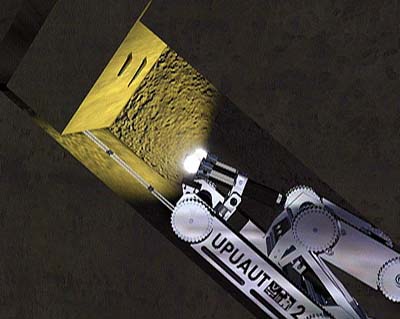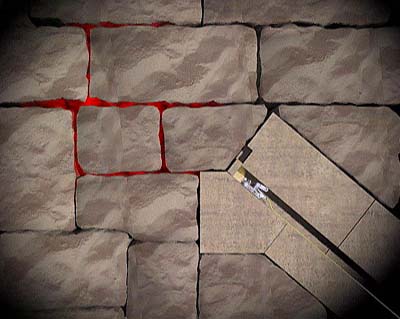|
1. When will exploration continue?
Since late March, 1993 my efforts to continue on-site investigation of the shafts of Cheops have been blocked by outside influences. But I am able and anxious to proceed at any time. Willing sponsors are already signed up, ensuring sufficient funding. Now it is time for the responsible authorities to finally give the green light. I have spent a great deal of time analyzing the video footage and all the other data we collected during our three campaigns, refining the concepts and processes, planning and preparing potential next steps.
Unfortunately these campaigns have been evaluated by others on the basis of superficial analysis of a single photograph - of the stone "closure" slab. But there is much more at stake. The three campaigns - constituting one of the most significant and thorough explorations ever conducted in the Cheops Pyramid - have brought to light a wealth of findings and discoveries which cry out for further investigation.
In the interest of scientific progress, I even offered - in 1994 - to step aside and provide the robot Upuaut-2, as well as to train the personnel to operate it correctly, so that investigation can continue.
BACK
TO THE LIST
What should be investigated further?
Foremost, of course, that mysterious slab, "the closure stone," to determine its function and significance.
But we have to keep in mind that we're still exploring the unknown. Major surprises can arise at any moment. So comprehensive, far-reaching plans are actually less useful than a series of small steps, to be taken one at a time.
Preliminary investigation of the slab could begin with trying to move it, simply by pushing on one corner. Any movement, no matter how slight, could provide data on how the original builders inserted the slab in the first place. And that in turn would tell us a lot about its function.
Next, we could insert a fine probe through the gap between the shaft floor and the bottom of the slab itself, in an attempt to learn what lies beyond.
We can also perform an ultrasound test, which would tell us the thickness of the slab, within a tolerance of about one centimeter. We would then know if we are dealing with a small block or a relatively thin slab, and whether the reverse side is rough or polished.
I suspect that the other side is polished, and am convinced that what our video inspection is showing us is the rear side of the slab. The slab's functional side is hidden from us. Why?
If a contemporary engineer was presented with the task of setting such a stone into place, he would drill two holes, insert a metal clamp and bend the protruding ends to prevent the clamp from slipping out. The result would look very much like what we are seeing.
So we could learn a lot about the function of the slab by performing an electrical test. Using the robot, we can attach electrodes to the two copper fittings and send a current through them. If we detect an electric circuit, we will have proved that there is an intact copper clamp on the other side. A clamp Cheops' builders might have used as a handle to fit the slab into the shaft.
The robot could also attempt to insert two capillary tubes into the gap under the slab. Then a special gas could be injected through the tubes and monitored on-line.

Upuaut-2 inserting two capillary tubes.

Move your cursor over the image to see how the gas behaves
if there is a hollow space on the other side of the stone slab.
ALTERNATIVE VIEW
If there is nothing behind the slab, the gas should escape through the gaps between the limestone blocks. But if there is a hermetically sealed cavity behind the slab, the gas would remain trapped. By measuring its volume, we could determine the volume of the cavity behind the slab � a few cubic liters, or perhaps even several cubic meters?
All these measures could be carried out for a relatively small investment, using existing equipment and technology with a number of modifications.
Only after such measures have been completed should a decision be made about what to do about the slab itself � for instance, to attempt to raise it, if it proves to be a "door", after all.
Whatever the plan, it must remain flexible. By the time we had mapped some 180 meters of the shafts � most of their overall length � we had still not encountered that horrendous "step" in the lower southern shaft, nor had we any idea that we were about to encounter the mysterious slab.
BACK
TO THE LIST
How important is investigation of the northern Queens Chamber shaft?
Ever since that sensational discovery in the lower southern shaft, the northern shaft has received little publicity. But exploring it might well help to solve the ongoing riddle of the southern lower shaft. We do not yet know how and where the northern shaft ends. Will we discover another stone slab blocking the way?
Not only that, the northern shaft itself may contain equally enticing mysteries.
In 1879, British archeologist Waynman Dixon retrieved a number of artifacts from the lower shaft northern. One of them was a small piece of a square wooden rod, which, unfortunately, has since disappeared. Another of his finds resembles a small grappling hook. The two rivets in the hook seem to match two holes in a square rod, presumably made of wood, which is still lodged about 18 meters up into the shaft.
(See THE LOWER NORTHERN SHAFT at THE FINDINGS page.)
I have carried out extensive modifications to the robots, giving them greater maneuverability to deal with bends in the shafts and differing shaft heights. So now, the northern lower shaft presents no major obstacles. We could explore it further with relative ease and at moderate cost. And we may be able to extract that enticing rod. If it does turn out to be made of wood, it can be carbon-dated. And that might well provide further evidence about the age of the Cheops Pyramid.
We should never forget that the upper region of this shaft constitutes the last remaining unexplored area of one of the world's most important historical monuments. We know it is there - and all we have to do is apply existing technology.
BACK
TO THE LIST
|

